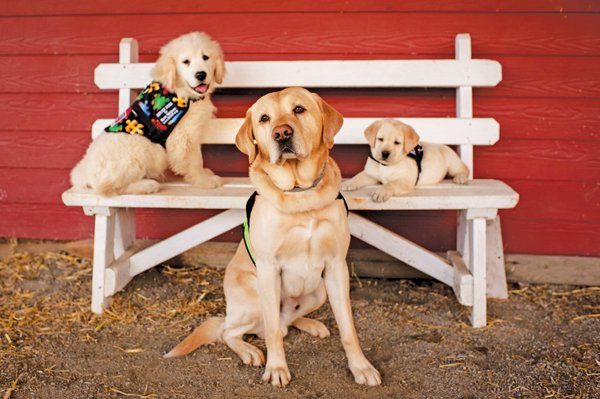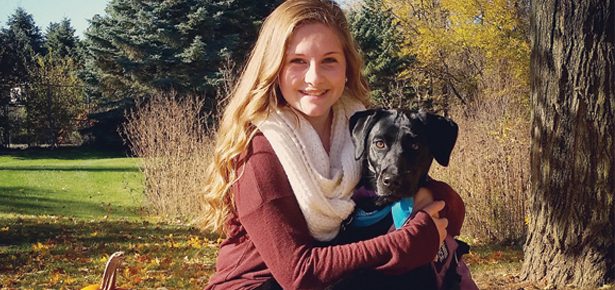
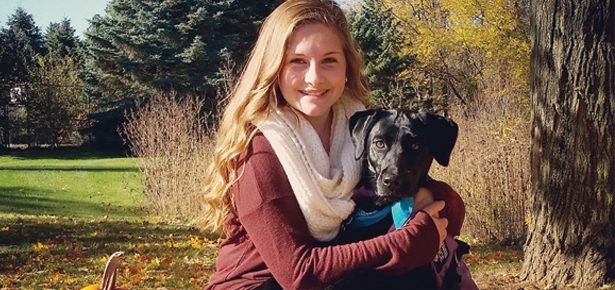
Lifesaving Dogs For Diabetics
Diabetic alert dogs are dramatically changing—and saving—lives
A flight from Pittsburgh back to her desert home near Bakersfield, California, could have turned deadly for type 1 diabetic Patti Kasper had she not had her trusty service dog, Tzaylie, by her side.
“There we were, mid-air in flyover country, and Tzaylie, which actually translates to ‘my shadow’ in Hebrew, starts to alert me like crazy,” Patti says, explaining that, as a diabetic alert dog, her beloved four-and-a-half-year-old black Labrador Retriever is trained to give a paw when she senses her master’s blood sugar levels are about to go or are going out of range. A second paw means high or going high while a nudge of the nose means low or going low—both dangerous situations that could result in seizures, comas, and even death. Tzaylie is also trained to retrieve third-party support, get food and medication—such as glucose tabs, insulin, juice, and meters—and even dial 911 on a special device.
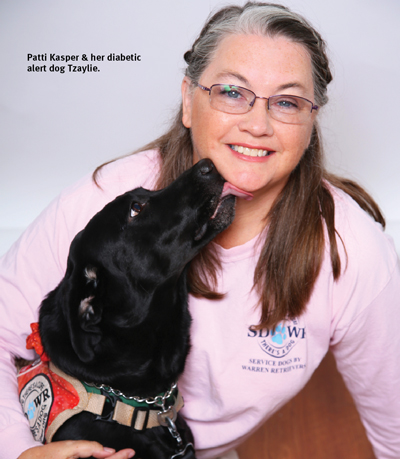
Tzaylie, she adds, “is absolutely amazing. She keeps me safe when I don’t have physical symptoms to clue me in or when I am, for example, fast asleep and unaware of what’s happening within my body. She’s even alerted my husband when she’s separated from me by distance that something is happening to my levels. She has saved my life dozens of times since I’ve had her. After 51 years of living with the disease, I can say without hesitation that this dog is the single greatest tool I’ve ever had in my tool kit, bar none.”
Patti obtained Tzaylie in October 2012 from Service Dogs By Warren Retrievers (SDWR), a non-profit organization in Madison, Virginia, that trains and places dogs with individuals who are living not only with type 1 and type 2 diabetes but also autism, PTSD, and seizure disorders. SDWR was founded by Dan Warren, himself a diabetic, to “help people with invisible diseases and disabilities better manage their health.”
It is, he says, “all about the nose. Our dogs are trained to recognize changes in blood sugar. A diabetic who is very high, believe it or not, smells sweet. That scent is quite different when he or she goes low. We teach our diabetic alert dogs to recognize the scent and, once they do, we teach them to alert on that scent as it’s fluctuating. And they won’t stop alerting until something is done to fix the problem.”
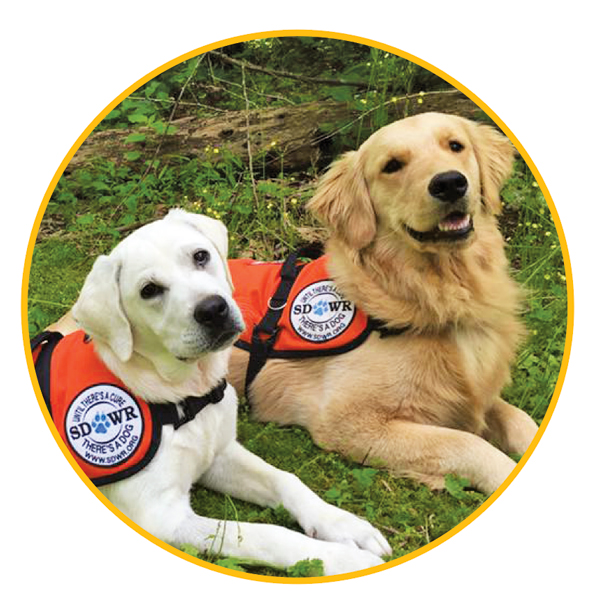
From there, puppies are placed with volunteer puppy raisers and fosters who work alongside SDWR training staff with an aim to teach each dog a grand total of 60 commands by 12 months of age—everything from sit and wait to get dressed and retrieve. Finally, at 18 months, the dogs are returned to SDWR for more formalized training and to round off any rough edges before being placed with a recipient family.
“When we place a dog it’s not, ‘Here’s your dog, see you later, good luck,’” emphasizes Dan. “We travel directly to each family for four or five days for acclimation and, really, to train the humans as equally as we’ve trained the dog. We then do an 18-month [long] follow-up program where we return to the family every three to four months for two to four days to reboot the humans, refine the skill set, tweak the dynamics, and ensure things become very fluid. During that time, we train the dog to detect the high and low blood sugar and to perform those tasks that can literally mean life or death for a diabetic.”
In terms of the benefits SDWR’s diabetic alert dogs provide, those range from the most practical and obvious—like alerting impending fluctuations in blood sugar levels and, as a result, yielding a more accurate and better-controlled A1C level with better glucose—right down to what Dan describes as the “emotional piece of the puzzle.”
“Diabetes is a very lonely disease,” he says. “It can be ravaging; you can feel that you’re going through life alone with this and, I’ll tell you, these dogs can help tremendously in that respect.”

It’s worth noting that it’s not for everyone, however. Of the 45 to 60 dogs SWDR places annually—and it has placed more than 500 dogs since 2008—Dan estimates five percent don’t work out, and there are no refunds. “If someone tells you they have a 100 percent success rate, run for the hills,” he notes. The reasons for an unsuccessful match differ depending on which side you talk to. A quick Google search yields disgruntled alert dog recipients who claim their dog didn’t alert, while the organization maintains some recipients won’t make themselves available for the acclimation and check-ins necessary once they’ve been matched with a dog. For his part, Dan stresses that he and his team exhaust all avenues to ensure a successful match.
For those it does work for, however, it’s nothing short of a godsend. Patti was so delighted with the SDWR process—from the fact that she wasn’t required to give up her other three dogs to the convenience of not having to travel back and forth for training—that she’s stayed on with the organization as a volunteer chapter manager for central California, where she helps others acquire their own diabetic alert dog.
One of those individuals is 13-year-old Emma Goldberg, from Thousand Oaks, California. Diagnosed with type 1 diabetes at age six, Emma and her mother, Kristina have been working diligently to raise the $25,000 required by SDWR—a pledge that, Dan says, helps to cover the costs of breeding, raising, and training the animals and helps keep the non-profit going. (According to other service providers we spoke to, including Becky Causey, owner of Causey Labradors and Training and president of the Diabetes Alert Dog Alliance, the price is “all over the board” and can range from as little as $500 to $30,000 or more, though on average, according to Diabetic Forecast magazine, a fully trained alert dog costs in the $20,000s.)
For their part, Emma and her mom Kristina are eagerly awaiting their dog.
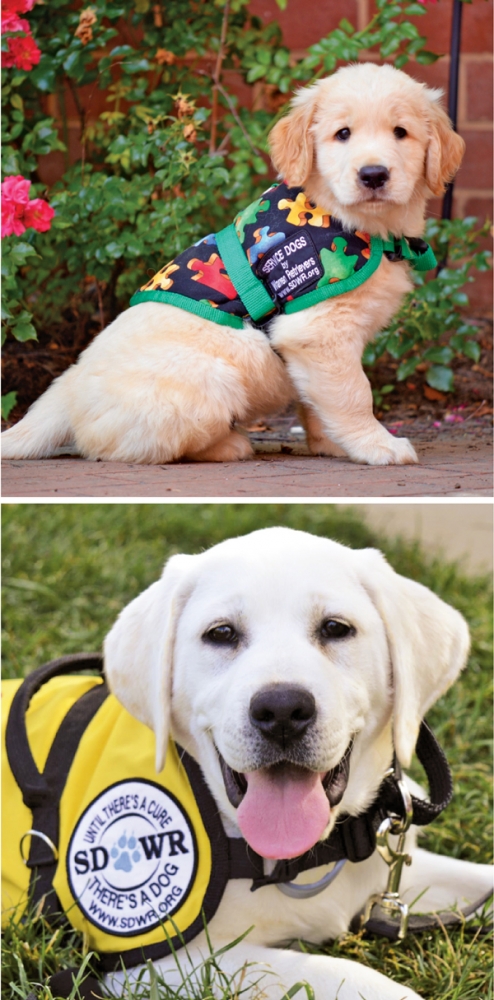
Kristina decided she could not imagine a future where her own daughter felt limited in doing something as common as attending university because of her diabetes. She decided to apply with SDWR—and hasn’t looked back since.
“As it is now, I pretty much sleep with Emma every night. I test her at two or three o’clock every morning to make sure she’s in a safe zone. The dog would alert her if she was going high or low—and everyone would sleep better,” she says. “SDWR has been amazing and very supportive about the fundraising portion, helping with printing posters and thinking of different fundraising ideas for us to try. It’s nice to know that we’re all working hard to make this happen.”
Thus far, the Goldbergs have hosted a garage sale, a makeover night, and a golf tournament to raise funds. Besides money, says Emma, “I also get to raise awareness about diabetic alert dogs and about type 1 diabetes. It feels pretty good to help more people know about it and understand what it is.”
“Diabetes is a day-to-day, 24-7 job—it does not ever let go,” adds her mom. “Having this dog is going to make everything easier for Emma, from testing [blood sugar levels] to going to school to sleeping, and it will make both her and I feel safer. If she needs something to eat the dog can go get it. If she wants to be home alone and I’m at work, she can be alone with her dog and know she’s safe. She’s going to be able to go on and live her life with a lot more confidence with this dog, and not have the day-to-day fears or concern that she has to watch herself constantly. Best of all, she’ll be able to lead this healthy, happy life with a true best friend and companion—her dog.”
—————————————————————————————————————————————
Getting a Diabetic Alert Dog
Besides SDWR, there are a number of diabetic alert dog organizations for people to choose from in the U.S. and Canada. Jennifer Cattet, owner of Medical Mutts in Indianapolis, says that with a rise in popularity of the dogs and, as such, a rise in the number of trainers, it’s crucial to do your homework before selecting a provider.
“Without standards in the service dog industry there can be big differences from one organization to the other,” Jennifer says, adding that she has heard cases of some trainers having no previous experience working with service dogs. “It’s always a good idea to do some research online. Look for reviews or complaints about the organization and/or the owner of the organization and ask for references. Make sure to ask about training style [and] make sure you agree with their methods before committing to working with them.”
Staying away from programs that charge full price for a puppy you will have to train yourself—even with their guidance—is also important, as is understanding what will happen if the dog does not work out. Does the organization provide another dog? Do they help you until things work out? Is it all your responsibility when you get the dog?
Building on this advice, Becky Causey, owner of Causey Labradors and Training and president of the Diabetes Alert Dog Alliance, says meeting with the trainer on more than one occasion and taking your time when asking questions is also key. “Ask for references and check them thoroughly, and ask to see a diabetic alert dog the trainer has trained in action, either in person or by video. Also, get a contract in writing and review it with an attorney prior to signing a contract—if you’re unable to hire an attorney…have at least three trusted friends or family members read it, too, to look for questionable content.”
That contract, Becky adds, should be specific about “what the dog will do, what guarantees are included for its performance, and what the consumer is required to do to maintain the dog’s training, as well as what the company is providing for support and what the costs are.” Do not, she warns, “sign a contract that says the dog might not work, or will need additional training by you…before it will work as a diabetic alert dog.”
As for success rates among diabetic alert dogs, while no official study has been done to yield hard numbers, Jennifer says it has a lot to do with human compliance—in other words, following the training instructions—and making the right match between person and dog. However, for her organization, the goal is for all placed dogs to alert at least 80 percent of the time and, she says, “We’ll keep working with our clients to reach that goal.”
Beverly Swartz, director of All Purpose Canines, echoes these sentiments. “In addition to the obvious, which is the training of the dog, there are a couple of things that greatly contribute to a successful diabetic alert dog. First, the family or individual must know what to do when the dog alerts, when it gives a false alert or if it fails to alert. I also believe that, once the dog is placed, follow-up communication is crucial to the success of the team. Initially the dogs are a lot of work, but the reward is so worth it.”
Join the newsletter and never miss out on dog content again!
"*" indicates required fields
By clicking the arrow, you agree to our web Terms of Use and Privacy & Cookie Policy. Easy unsubscribe links are provided in every email.
